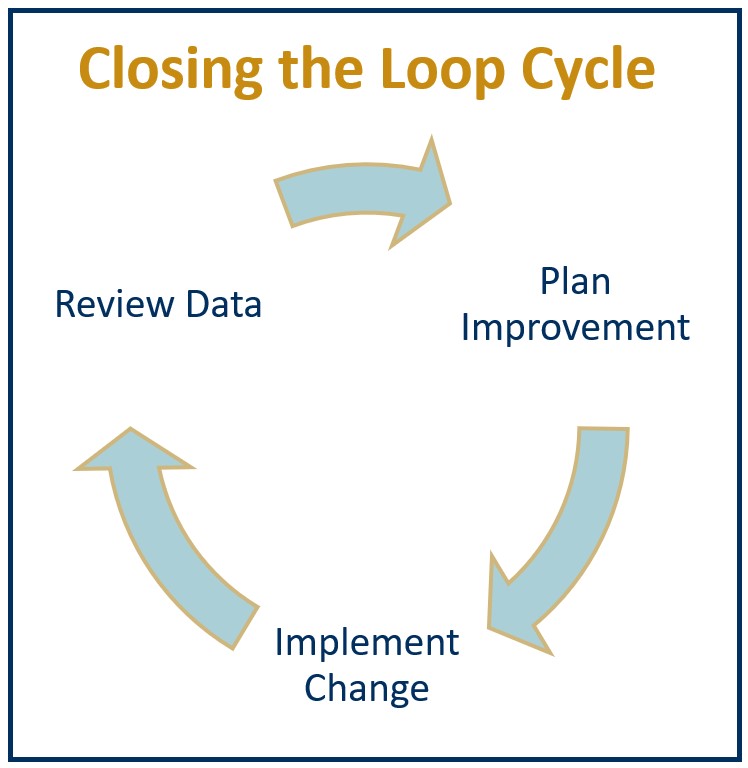University Assessment System
Closing the Loop
Closing the Loop
|
The most important part of the continuous improvement process is "closing the loop". Closing the loop occurs when faculty review learning outcome data, implement changes based on the data, and collect additional data to determined the impact of the changes. While faculty discuss program changes regularly throughout the year, time is also given each fall and spring semester for departmental assessment meetings. During this time faculty:
|
 |
EXAMPLE | International Relations (B.A.) Improvement Plan
Furthermore, each program documents their individual continuous improvement process and continuous improvement changes on a regular basis:
EXAMPLE | Ministry & leadership (B.A.) Continuous Improvement Process Description
EXAMPLE | Nursing (B.S.N.) Continuous Improvement Changes
Using Data for Continuous Improvement:
Program |
Improvement |
||||||||||||
| Dance (B.A.) |
In 2018, the program outcome #1 score for Dance (B.A.) was 2.98/4.00. This outcome measures students’ ability to create and defend choreographic works. To improve this area, faculty members:
By 2020, the score for this outcome increased to 3.80/4.00. |
||||||||||||
| Management (B.S.) |
The Management (B.S.) program draws data from the Strategic Management (MGT 431) course for program outcomes three, four, and six. In the course, students demonstrate an understanding of firms' operations within industries from a macro perspective and the implementation of strategic planning. In fall 2018, scores were below the target of 3.5. Faculty recognized the need to improve the course by:
Scores improved as follows:
|
||||||||||||
| Elementary Education (B.Ed.) |
In 2018, students scored a 220.59 average on the written constructed response in the Oklahoma Subject Area Test compared with a 221.1 state average. In response, the faculty began:
By 2020, scores on the section improved to a 234.5 average. |
||||||||||||
| Nursing (B.S.N.) |
Graduates from the Nursing (B.S.) program in 2017 had an NCLEX-RN licensure pass rate of 79.55 percent, below the national average of 87.12 percent. Faculty members began:
By 2018, the average NCLEX-RN pass rate rose to 94 percent and remains above the national average. |
||||||||||||
| Engineering (B.S.E.) |
In 2017, upper-division students in the Engineering (B.S.) program earned scores of 2.68/4.00 for Engineering outcome (a), the ability “to apply knowledge of mathematics, science, and engineering” due to a persistent struggle with vectors and free-body diagrams. The Engineering faculty members:
In 2022, primarily based on the changes, the Physics final exam scores increased from 66.8 percent in 2017 to 91.0 percent. |
||||||||||||
| Ministry & Leadership (B.A.) |
In the Ministry & Leadership program, as well as the entire College of Theology and Ministry, faculty have been tracking persistently low residential scores for “Style and Format,” with 2.97/4.00 in 2020-21, 3.27 in 2021-22, and 2.94 in 2022-23. Following an assessment of the problem from an overall program point-of-view, faculty members have identified that using multiple format styles (e.g., Turabian, SBL, and APA) in different courses may lead to student confusion. In 2022-23, faculty initiated a thorough revision of the Undergraduate Style manual and are implmenting it in 2023-24. Results of these changes are forthcoming. |
Closing the Loop
Assessment System Continuous Improvement
Recent Improvements
- Program improvement plans incorporated into the new Annual Improvement Plan template
Next Steps
- Continually evaluate the impact of program changes to improve student learning
- Improve "closing the loop" descriptions and data-informed annual improvement plans

